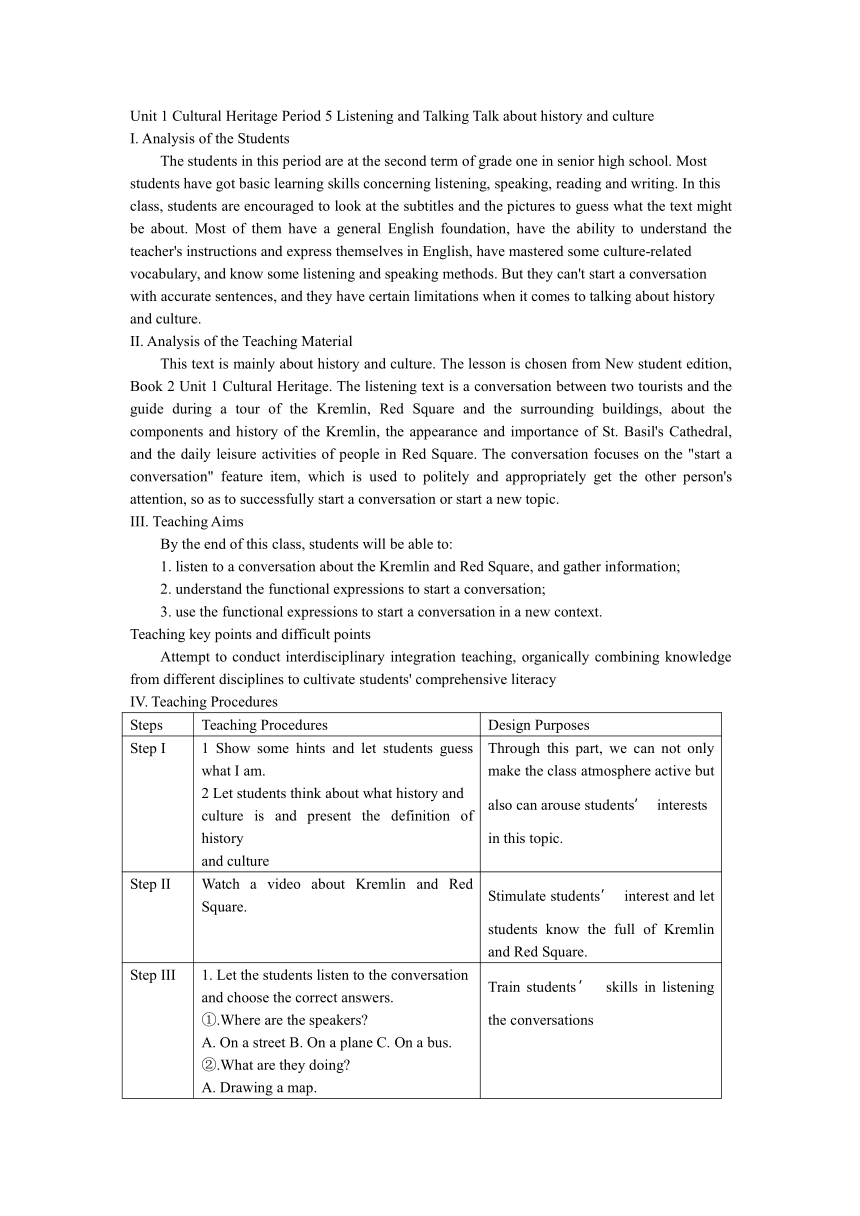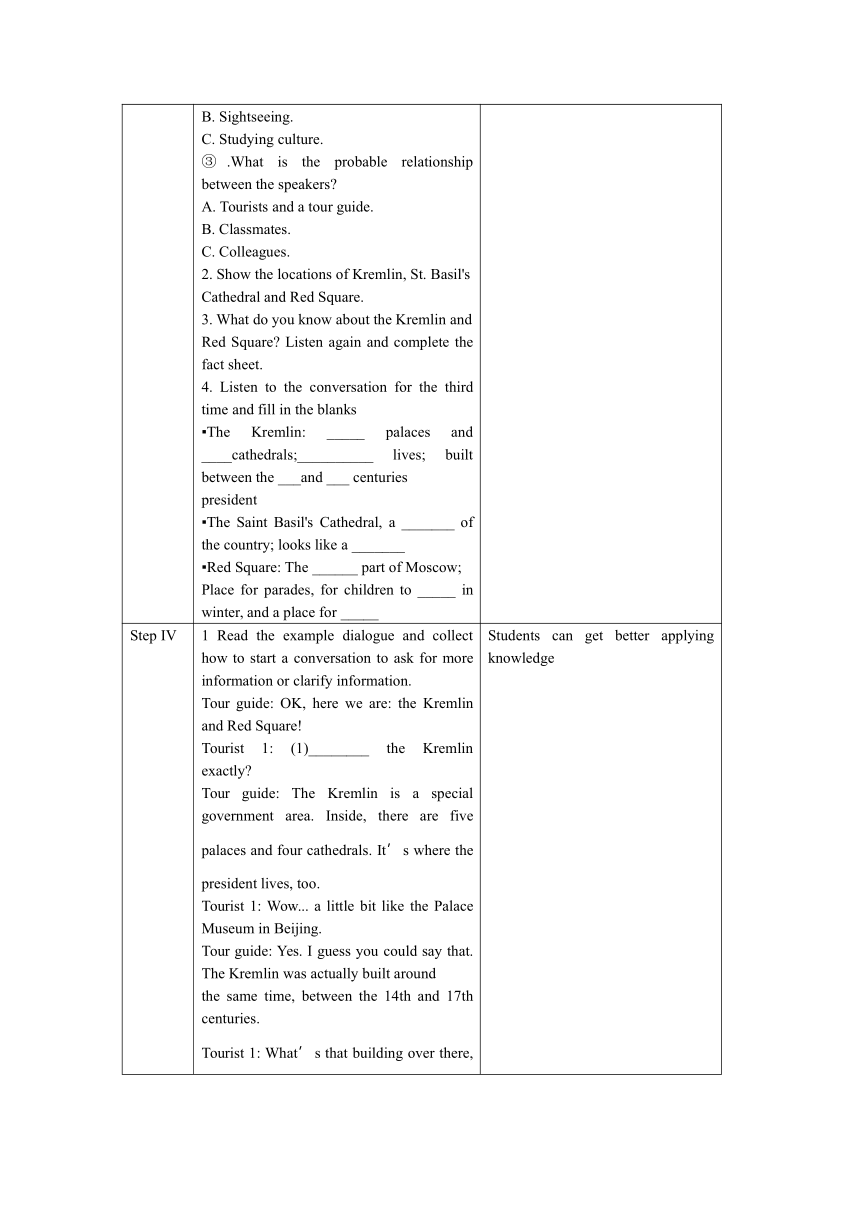人教版(2019)必修第二册Unit 1 Cultural Heritage Listening and Talking 教学设计(表格式)
文档属性
| 名称 | 人教版(2019)必修第二册Unit 1 Cultural Heritage Listening and Talking 教学设计(表格式) |  | |
| 格式 | docx | ||
| 文件大小 | 69.1KB | ||
| 资源类型 | 教案 | ||
| 版本资源 | 人教版(2019) | ||
| 科目 | 英语 | ||
| 更新时间 | 2025-01-01 12:29:22 | ||
图片预览


文档简介
Unit 1 Cultural Heritage Period 5 Listening and Talking Talk about history and culture
I. Analysis of the Students
The students in this period are at the second term of grade one in senior high school. Most
students have got basic learning skills concerning listening, speaking, reading and writing. In this
class, students are encouraged to look at the subtitles and the pictures to guess what the text might be about. Most of them have a general English foundation, have the ability to understand the teacher's instructions and express themselves in English, have mastered some culture-related
vocabulary, and know some listening and speaking methods. But they can't start a conversation
with accurate sentences, and they have certain limitations when it comes to talking about history
and culture.
II. Analysis of the Teaching Material
This text is mainly about history and culture. The lesson is chosen from New student edition, Book 2 Unit 1 Cultural Heritage. The listening text is a conversation between two tourists and the guide during a tour of the Kremlin, Red Square and the surrounding buildings, about the components and history of the Kremlin, the appearance and importance of St. Basil's Cathedral, and the daily leisure activities of people in Red Square. The conversation focuses on the "start a conversation" feature item, which is used to politely and appropriately get the other person's attention, so as to successfully start a conversation or start a new topic.
III. Teaching Aims
By the end of this class, students will be able to:
1. listen to a conversation about the Kremlin and Red Square, and gather information;
2. understand the functional expressions to start a conversation;
3. use the functional expressions to start a conversation in a new context.
Teaching key points and difficult points
Attempt to conduct interdisciplinary integration teaching, organically combining knowledge from different disciplines to cultivate students' comprehensive literacy
IV. Teaching Procedures
Steps Teaching Procedures Design Purposes
Step I 1 Show some hints and let students guess what I am. 2 Let students think about what history and culture is and present the definition of history and culture Through this part, we can not only make the class atmosphere active but also can arouse students’ interests in this topic.
Step II Watch a video about Kremlin and Red Square. Stimulate students’ interest and let students know the full of Kremlin and Red Square.
Step III 1. Let the students listen to the conversation and choose the correct answers. ①.Where are the speakers A. On a street B. On a plane C. On a bus. ②.What are they doing A. Drawing a map. B. Sightseeing. C. Studying culture. ③.What is the probable relationship between the speakers A. Tourists and a tour guide. B. Classmates. C. Colleagues. 2. Show the locations of Kremlin, St. Basil's Cathedral and Red Square. 3. What do you know about the Kremlin and Red Square Listen again and complete the fact sheet. 4. Listen to the conversation for the third time and fill in the blanks The Kremlin: _____ palaces and ____cathedrals;__________ lives; built between the ___and ___ centuries president The Saint Basil's Cathedral, a _______ of the country; looks like a _______ Red Square: The ______ part of Moscow; Place for parades, for children to _____ in winter, and a place for _____ Train students’ skills in listening the conversations
Step IV 1 Read the example dialogue and collect how to start a conversation to ask for more information or clarify information. Tour guide: OK, here we are: the Kremlin and Red Square! Tourist 1: (1)________ the Kremlin exactly Tour guide: The Kremlin is a special government area. Inside, there are five palaces and four cathedrals. It’s where the president lives, too. Tourist 1: Wow... a little bit like the Palace Museum in Beijing. Tour guide: Yes. I guess you could say that. The Kremlin was actually built around the same time, between the 14th and 17th centuries. Tourist 1: What’s that building over there, with the colourful round towers I’ve seen so many photos of it. It looks so pretty, like a flame! Tour guide: That’s Saint Basil’s Cathedral. People all over the world think of Russia when they see it. It’s like the Eiffel Tower in France or the Great Wall in China, a symbol of the country. Tourist 2: (2)________ can you tell me more about Red Square Tour guide: Well, it’s considered the centre of Moscow, and there have been many important parades and events held here. It also used to be a marketplace a long time ago. Tourist 2: Oh, really How amazing! Tour guide: I see that you’re looking at the photos of an ice hockey game. (3)________ children can skate on Red Square in the winter Tourist 2: No way! That’s so cool! Tour guide: Yes. Red Square is also a place for music concerts. People have a lot of fun here. 2 Teacher summarize the skills of introducing a cultural relic. Students can get better applying knowledge
Step V 1 Work in groups and role play. Choose a cultural site that you like and role-play a conversation between some tourists and their tour guide. Take turns to play the different roles. 2 Individual presentation. Volunteers can introduce their favorite sites with their partners. Each group can share their own ideas by this step. And it can Cultivate their oral English and build up their confidence
Step VI 1. Review. 2. Homework. Write an essay to introduce the cultural site you like most to others. This step can help students consolidate what they learned today.
教学反思 Unit 1 Listening and talking 一、课堂互动 亮点: 采用了小组讨论和角色扮演的方式,学生们的参与度非常高,课堂气氛活跃。在小组讨论中学生们能够积极发表自己的观点,互相倾听和学习,培养了团队合作精神和沟通能力。角色扮演则让学生们更好地理解了听力文本中的角色和情感,增强了学习的趣味性。 不足: 部分学生在小组讨论中存在参与度不均衡的问题,有些学生过于积极,而有些学生则比较沉默。此外,在角色扮演时,有些学生不够投入,表演效果不够理想。改进措施:在小组讨论中,采用轮流发言的方式,确保每个学生都有机会参与。对于比较沉默的学生给予更多的关注和鼓励,引导他们积极发言。在角色扮演前,进行更充分的准备工作,包括讲解角色特点情感表达等,提高学生的表演水平。 二、教学方法 亮点: 采用了多种教学方法,如讲授法、讨论法、直观等,同时,注重启发式教学,引导学 生积极思考,培养了学生的创新思维和解决问题的能力。 不足: 在启发式教学中,问题的设计不够巧妙,不能很好地引导学生思考。 改进措施: 加强对教学方法的研究和学习,了解各种教学方法的优缺点和适用范围,根据教 学内容和学生的特点灵活选择教学方法。在启发式教学中,精心设计问题,提高问题的质量和针对性,引导学生深入思考。 三、技术整合 亮点:积极运用现代信息技术,如多媒体教学、在线教学平台等,丰富教学资源,提高教学效率。同时,注重培养学生的信息素养,引导学生正确使用信息技术进行学习和研究。 不足: 在技术整合方面,还存在一些不足。有时会因为技术问题而影响教学进度,此外,在培养学生信息素养方面,还需要进一步加强。 改进措施: 加强对现代信息技术的学习和掌握,提高技术水平,确保教学顺利进行。在培养 学生信息素养方面,要制定具体的教学计划和目标,通过课堂教学和实践活动等方式,提高学生的信息素养。 四、作业设计 亮点:作业设计新颖,较好地结合了上课内容,锻炼了学生的知识运用能力。 不足:作业设计应多样化,包括书面作业、实践作业、阅读作业等,满足不同学生的学习需求。同时注重作业的分层设计,根据学生的学习能力和水平布置不同难度的作业,提高作业的针对性和有效性。 五、跨学科融合 亮点:尝试进行跨学科融合教学,将不同学科的知识有机地结合起来,培养学生的综合素养。 不足:在跨学科融合方面,还存在一些不足。有时会因为学科知识的限制而无法进行深入的融合。此外在跨学科教学的组织和实施方面,还需要进一步提高。 改进措施: 加强对不同学科知识的学习和了解,拓宽自己的知识面。在跨学科教学的组织和 实施方面要与其他学科教师进行充分的沟通和合作,共同制定教学计划和方案,提高跨学科教学的效果。 六、自我反思 能够及时进行自我反思,总结教学中的经验教训,不断改进自己的教学方法和策略。学生本节课的整体掌握情况较好,还有个别同学存在疑难问题,要及时安排个别辅导,同时,虚心听取学生和同事的意见和建议,不断提高自己的教学水平。
I. Analysis of the Students
The students in this period are at the second term of grade one in senior high school. Most
students have got basic learning skills concerning listening, speaking, reading and writing. In this
class, students are encouraged to look at the subtitles and the pictures to guess what the text might be about. Most of them have a general English foundation, have the ability to understand the teacher's instructions and express themselves in English, have mastered some culture-related
vocabulary, and know some listening and speaking methods. But they can't start a conversation
with accurate sentences, and they have certain limitations when it comes to talking about history
and culture.
II. Analysis of the Teaching Material
This text is mainly about history and culture. The lesson is chosen from New student edition, Book 2 Unit 1 Cultural Heritage. The listening text is a conversation between two tourists and the guide during a tour of the Kremlin, Red Square and the surrounding buildings, about the components and history of the Kremlin, the appearance and importance of St. Basil's Cathedral, and the daily leisure activities of people in Red Square. The conversation focuses on the "start a conversation" feature item, which is used to politely and appropriately get the other person's attention, so as to successfully start a conversation or start a new topic.
III. Teaching Aims
By the end of this class, students will be able to:
1. listen to a conversation about the Kremlin and Red Square, and gather information;
2. understand the functional expressions to start a conversation;
3. use the functional expressions to start a conversation in a new context.
Teaching key points and difficult points
Attempt to conduct interdisciplinary integration teaching, organically combining knowledge from different disciplines to cultivate students' comprehensive literacy
IV. Teaching Procedures
Steps Teaching Procedures Design Purposes
Step I 1 Show some hints and let students guess what I am. 2 Let students think about what history and culture is and present the definition of history and culture Through this part, we can not only make the class atmosphere active but also can arouse students’ interests in this topic.
Step II Watch a video about Kremlin and Red Square. Stimulate students’ interest and let students know the full of Kremlin and Red Square.
Step III 1. Let the students listen to the conversation and choose the correct answers. ①.Where are the speakers A. On a street B. On a plane C. On a bus. ②.What are they doing A. Drawing a map. B. Sightseeing. C. Studying culture. ③.What is the probable relationship between the speakers A. Tourists and a tour guide. B. Classmates. C. Colleagues. 2. Show the locations of Kremlin, St. Basil's Cathedral and Red Square. 3. What do you know about the Kremlin and Red Square Listen again and complete the fact sheet. 4. Listen to the conversation for the third time and fill in the blanks The Kremlin: _____ palaces and ____cathedrals;__________ lives; built between the ___and ___ centuries president The Saint Basil's Cathedral, a _______ of the country; looks like a _______ Red Square: The ______ part of Moscow; Place for parades, for children to _____ in winter, and a place for _____ Train students’ skills in listening the conversations
Step IV 1 Read the example dialogue and collect how to start a conversation to ask for more information or clarify information. Tour guide: OK, here we are: the Kremlin and Red Square! Tourist 1: (1)________ the Kremlin exactly Tour guide: The Kremlin is a special government area. Inside, there are five palaces and four cathedrals. It’s where the president lives, too. Tourist 1: Wow... a little bit like the Palace Museum in Beijing. Tour guide: Yes. I guess you could say that. The Kremlin was actually built around the same time, between the 14th and 17th centuries. Tourist 1: What’s that building over there, with the colourful round towers I’ve seen so many photos of it. It looks so pretty, like a flame! Tour guide: That’s Saint Basil’s Cathedral. People all over the world think of Russia when they see it. It’s like the Eiffel Tower in France or the Great Wall in China, a symbol of the country. Tourist 2: (2)________ can you tell me more about Red Square Tour guide: Well, it’s considered the centre of Moscow, and there have been many important parades and events held here. It also used to be a marketplace a long time ago. Tourist 2: Oh, really How amazing! Tour guide: I see that you’re looking at the photos of an ice hockey game. (3)________ children can skate on Red Square in the winter Tourist 2: No way! That’s so cool! Tour guide: Yes. Red Square is also a place for music concerts. People have a lot of fun here. 2 Teacher summarize the skills of introducing a cultural relic. Students can get better applying knowledge
Step V 1 Work in groups and role play. Choose a cultural site that you like and role-play a conversation between some tourists and their tour guide. Take turns to play the different roles. 2 Individual presentation. Volunteers can introduce their favorite sites with their partners. Each group can share their own ideas by this step. And it can Cultivate their oral English and build up their confidence
Step VI 1. Review. 2. Homework. Write an essay to introduce the cultural site you like most to others. This step can help students consolidate what they learned today.
教学反思 Unit 1 Listening and talking 一、课堂互动 亮点: 采用了小组讨论和角色扮演的方式,学生们的参与度非常高,课堂气氛活跃。在小组讨论中学生们能够积极发表自己的观点,互相倾听和学习,培养了团队合作精神和沟通能力。角色扮演则让学生们更好地理解了听力文本中的角色和情感,增强了学习的趣味性。 不足: 部分学生在小组讨论中存在参与度不均衡的问题,有些学生过于积极,而有些学生则比较沉默。此外,在角色扮演时,有些学生不够投入,表演效果不够理想。改进措施:在小组讨论中,采用轮流发言的方式,确保每个学生都有机会参与。对于比较沉默的学生给予更多的关注和鼓励,引导他们积极发言。在角色扮演前,进行更充分的准备工作,包括讲解角色特点情感表达等,提高学生的表演水平。 二、教学方法 亮点: 采用了多种教学方法,如讲授法、讨论法、直观等,同时,注重启发式教学,引导学 生积极思考,培养了学生的创新思维和解决问题的能力。 不足: 在启发式教学中,问题的设计不够巧妙,不能很好地引导学生思考。 改进措施: 加强对教学方法的研究和学习,了解各种教学方法的优缺点和适用范围,根据教 学内容和学生的特点灵活选择教学方法。在启发式教学中,精心设计问题,提高问题的质量和针对性,引导学生深入思考。 三、技术整合 亮点:积极运用现代信息技术,如多媒体教学、在线教学平台等,丰富教学资源,提高教学效率。同时,注重培养学生的信息素养,引导学生正确使用信息技术进行学习和研究。 不足: 在技术整合方面,还存在一些不足。有时会因为技术问题而影响教学进度,此外,在培养学生信息素养方面,还需要进一步加强。 改进措施: 加强对现代信息技术的学习和掌握,提高技术水平,确保教学顺利进行。在培养 学生信息素养方面,要制定具体的教学计划和目标,通过课堂教学和实践活动等方式,提高学生的信息素养。 四、作业设计 亮点:作业设计新颖,较好地结合了上课内容,锻炼了学生的知识运用能力。 不足:作业设计应多样化,包括书面作业、实践作业、阅读作业等,满足不同学生的学习需求。同时注重作业的分层设计,根据学生的学习能力和水平布置不同难度的作业,提高作业的针对性和有效性。 五、跨学科融合 亮点:尝试进行跨学科融合教学,将不同学科的知识有机地结合起来,培养学生的综合素养。 不足:在跨学科融合方面,还存在一些不足。有时会因为学科知识的限制而无法进行深入的融合。此外在跨学科教学的组织和实施方面,还需要进一步提高。 改进措施: 加强对不同学科知识的学习和了解,拓宽自己的知识面。在跨学科教学的组织和 实施方面要与其他学科教师进行充分的沟通和合作,共同制定教学计划和方案,提高跨学科教学的效果。 六、自我反思 能够及时进行自我反思,总结教学中的经验教训,不断改进自己的教学方法和策略。学生本节课的整体掌握情况较好,还有个别同学存在疑难问题,要及时安排个别辅导,同时,虚心听取学生和同事的意见和建议,不断提高自己的教学水平。
